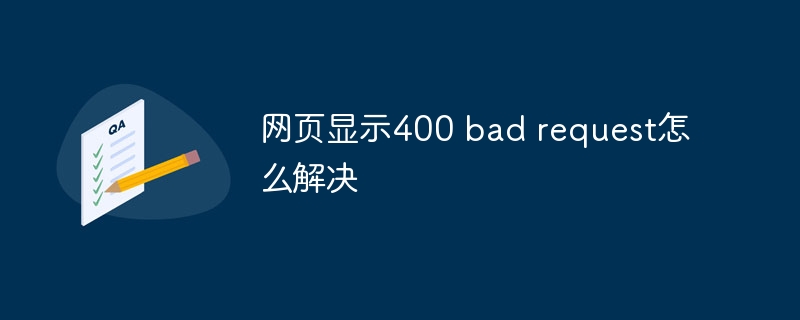
400 bad request solution: 1. Check the syntax of the request; 2. Check the request header; 3. Check the request parameters; 4. Check the network connection; 5. Check the server configuration; 6. Use developer tools; 7. Debug the code; 8. Update the software version; 9. Ask for help, etc.

When a web page displays a "400 Bad Request" error, it is usually because the request sent by the client does not meet the server's requirements, causing the server to be unable to correctly understand the request and Return a valid response. To resolve this issue, the following steps can be taken:
Check the syntax of the request: First make sure that the request sent is grammatically correct and has no spelling errors or formatting errors. Depending on the type of request (GET, POST, etc.), ensure that the format of the request conforms to the specification.
Check request headers: Sometimes, the server may have specific requirements for request headers. Check that request headers are set correctly, especially those related to authentication, character encoding, or other specific server requirements. Make sure that the name and value of each header field conforms to the specification.
Check request parameters: If the request contains parameters (such as passing query parameters in the URL), make sure the parameters are well-formed and do not violate any character restrictions. Check whether the parameter value meets the server's requirements.
Check the network connection: Sometimes, the "400 Bad Request" error may be caused by network connection issues. Make sure you have a good network connection and can access the target server. Try testing the same request on another device or network environment to see if the problem persists.
Check the server configuration: If the above steps do not solve the problem, it may be due to server configuration issues. The "400 Bad Request" error is usually returned by the server, so it may be related to the configuration on the server. You can try contacting the server's administrator or developer to find out if there are any specific configuration requirements or restrictions.
Use developer tools: In the browser, you can use developer tools (such as Chrome's developer tools) to view more error details . In the Network tab of the Developer Tools, you can view detailed logs of requests, including the full contents of the request. This can help you determine the specific cause of the problem.
Debug code: If you have permission to access the server, you can try to add debug code on the server side to check the specific content of the request. For example, you can add logging statements to your server-side code to record relevant information when a request reaches the server. This helps identify problems and find solutions.
Update software version: Sometimes, a specific software version may have bugs or problems, causing the "400 Bad Request" error to appear. Make sure that the browser, operating system or other related software you are using is the latest version to avoid problems caused by outdated software versions.
Ask for help: If none of the above steps solve the problem, you can try to ask for help. Consult relevant technical support, forums, or communities to seek help from experienced developers or experts. They may be able to provide more specific solutions or guide you to further troubleshoot the issue.
Please note that the "400 Bad Request" error is a very common HTTP error code, usually caused by the request sent by the client not meeting the server's requirements. Solving this problem requires carefully checking all aspects of the request's syntax, headers, parameters, etc., and ensuring that it is consistent with the server's requirements. Depending on the situation, you may need to further debug your code or contact your server administrator for additional support.
The above is the detailed content of How to solve the problem of 400 bad request when the web page displays. For more information, please follow other related articles on the PHP Chinese website!




